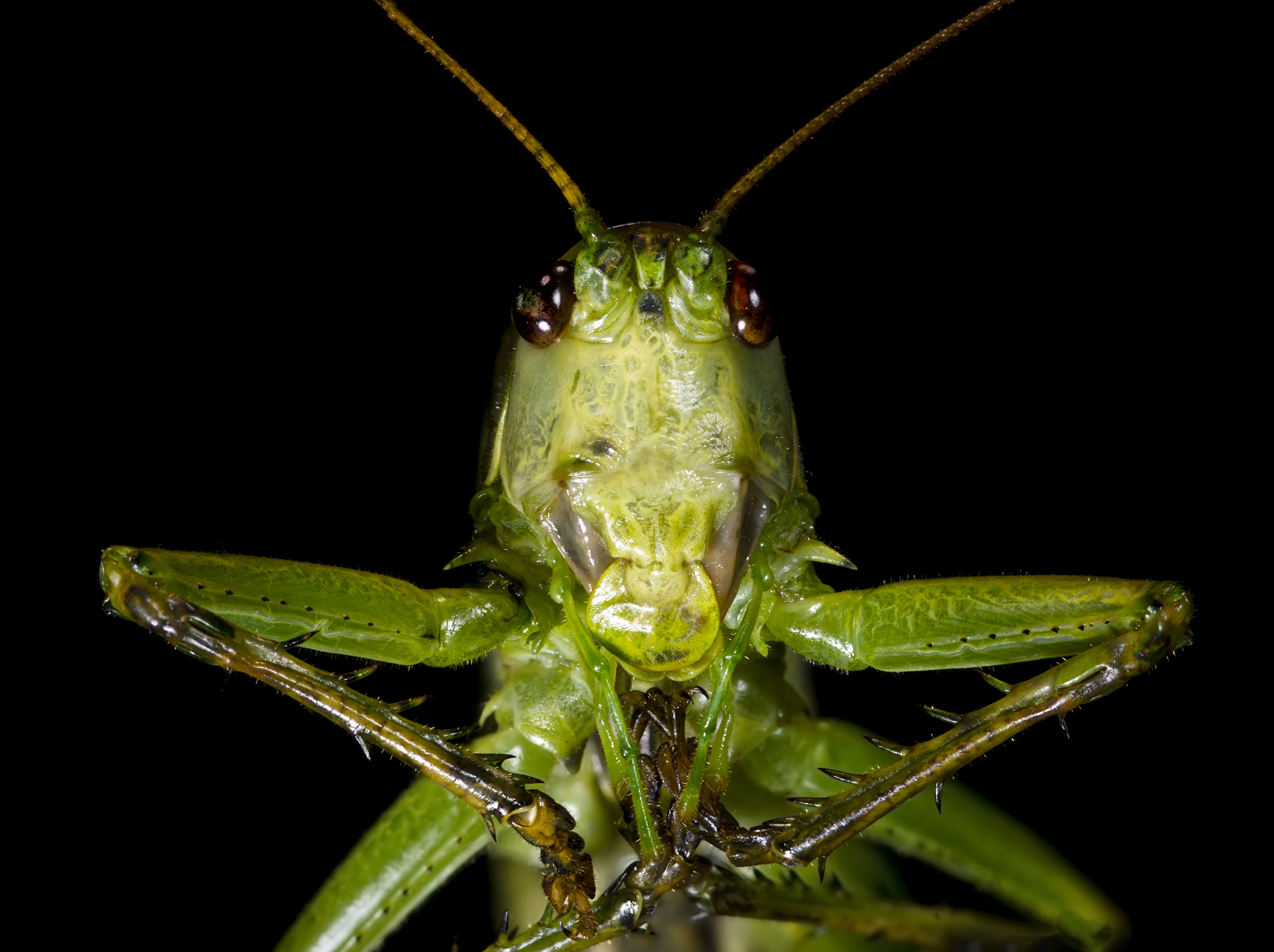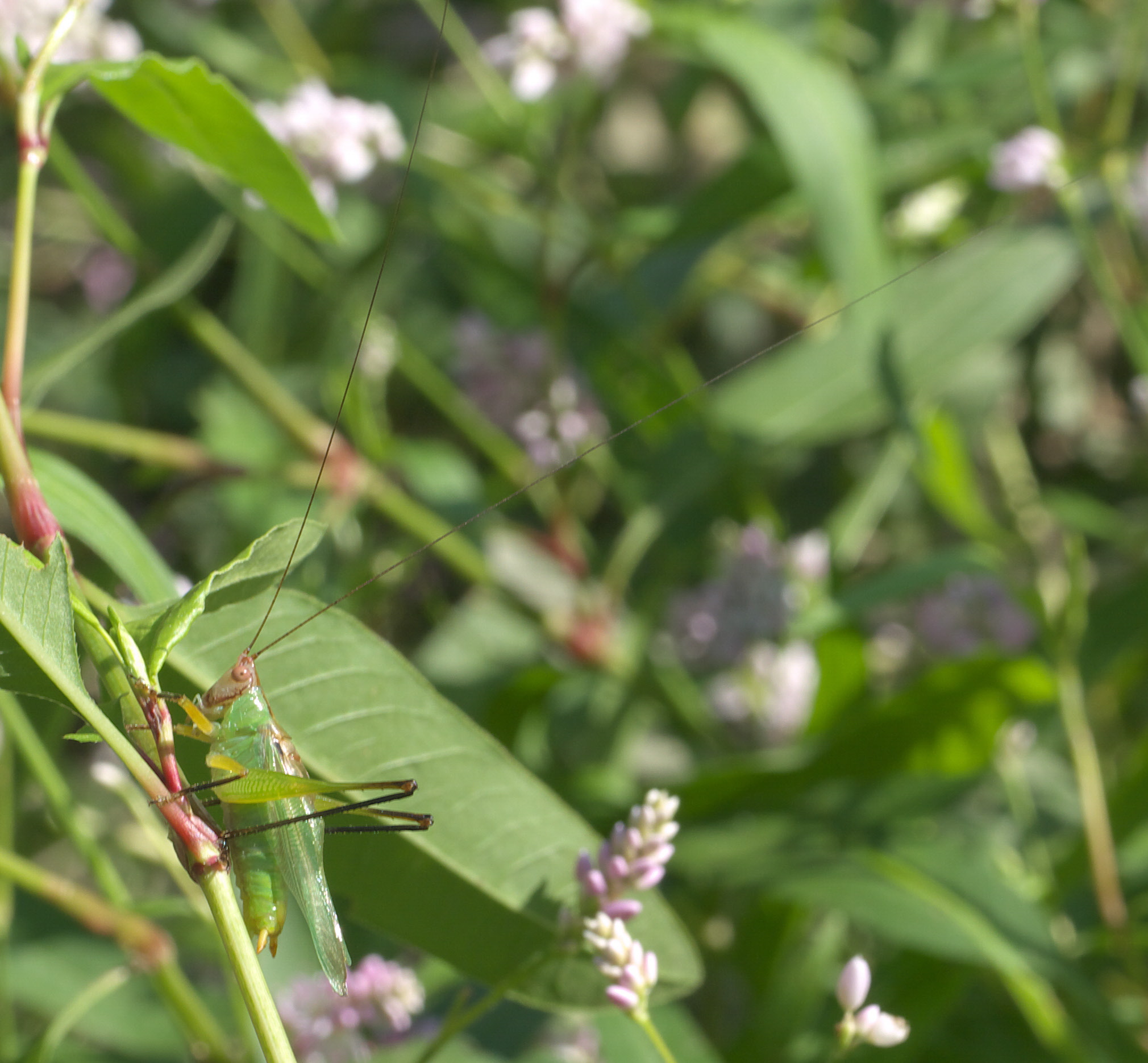|
Orchelimum Pulchellum
''Orchelimum pulchellum'', the handsome meadow katydid, is a species of meadow katydid in the family Tettigoniidae. It is found in North America. Description The body length of the handsome meadow katydid is . This katydid is distinguished from ''Orchelimum nigripes'', its western relative, by the shape of the caudal portion of its lateral pronotum, which is arcuate inferior to the humeral sinus in ''O. pulchellum'', while the same portion is sinuate or sub-sinuate in ''O. nigripes''. The medial tooth on each of the paired male cerci in ''O. pulchellum'' is positioned at a less acute angle to the sinuate sinus of the cercus in ''O. pulchellum'' when compared to that of ''O. nigripes''. In females, the ovipositor is long and sickle shaped. The tibiae are brown in ''O. pulchellum'', while they are typically black in ''O. nigripes''. ''O. pulchellum'' typically has no spines on the inner carinae of the hind femora, which distinguishes it from another relative, Orchelimum carin ... [...More Info...] [...Related Items...] OR: [Wikipedia] [Google] [Baidu] |
Tettigoniidae
Insects in the family Tettigoniidae are commonly called katydids (especially in North America), or bush crickets. They have previously been known as "long-horned grasshoppers". More than 8,000 species are known. Part of the suborder Ensifera, the Tettigoniidae are the only extant (living) family in the superfamily Tettigonioidea. They are primarily nocturnal in habit with strident mating calls. Many species exhibit mimicry and camouflage, commonly with shapes and colors similar to leaves. Etymology The family name Tettigoniidae is derived from the genus '' Tettigonia'', first described by Carl Linnaeus in 1758. In Latin ''tettigonia'' means a kind of small cicada, leafhopper; it is from the Greek τεττιγόνιον ''tettigonion'', the diminutive of the imitative ( onomatopoeic) τέττιξ, ''tettix'', cicada. All of these names such as ''tettix'' with repeated sounds are onomatopoeic, imitating the stridulation of these insects. The common name ''katydid'' is also on ... [...More Info...] [...Related Items...] OR: [Wikipedia] [Google] [Baidu] |
Handsome Meadow Katydid - Orchelimum Pulchellum, Occoquan Bay National Wildlife Refuge, Woodbridge, Virginia
Handsome may refer to: *Physical attractiveness *Human physical appearance Music * Handsome (band), an American rock band Albums * ''Handsome'' (EP), 1989 EP by American band Tar * ''Handsome'' (Handsome album), 1997 * ''Handsome'' (Kilburn and the High-Roads album), 1975 Songs * "Handsome" (song), a 2015 song by The Vaccines *"Handsome", a 1991 song by Camouflage from ''Meanwhile'' *"Handsome", a 2008 song by Sky Larkin *"Handsome", a 2019 song by Chance the Rapper featuring Megan Thee Stallion from '' The Big Day'' *"Handsome", a 2020 song by Dave East from '' Karma 3'' Film *'' Handsome: A Netflix Mystery Movie'', 2017 *Rocky Handsome: a 2016 Hindi Movie People *Ara the Handsome, a legendary Armenian hero *Fernando I the Handsome (1345–1383), King of the Kingdom of Portugal *Geoffrey the Handsome or Geoffrey Plantagenet (1113–1151), Count of Anjou, Duke of Normandy, and father of King Henry II of England * Oleg I the Handsome (13th century), Prince of Ryazan (in presen ... [...More Info...] [...Related Items...] OR: [Wikipedia] [Google] [Baidu] |
Orchelimum Nigripes
''Orchelimum nigripes'', known generally as the black-legged meadow katydid or red-legged meadow grasshopper, is a species of meadow katydid in the family Tettigoniidae. It is found in North America. Male Black-legged Meadow Katydid stridulating.webm, Male stridulating See also *''Orchelimum pulchellum'' – a similar species with which ''O. nigripes'' hybridizes in the southeastern part of its range and along a portion of the Potomac River, the latter case possibly the product of an introduced species, introduced population of ''O. nigripes'' References External links * Orchelimum, nigripes Articles created by Qbugbot Insects described in 1875 {{tettigoniidae-stub ... [...More Info...] [...Related Items...] OR: [Wikipedia] [Google] [Baidu] |
Orchelimum Carinatum
''Orchelimum'' is a genus of katydid with 21 known species. Species The following species are recognised in the genus ''Orchelimum'': * Subgenus ''Metarhoptrum'' Rehn & Hebard, 1915 ** '' Orchelimum fraternum'' Rehn & Hebard, 1915 ** '' Orchelimum superbum'' Rehn & Hebard, 1915 ** '' Orchelimum unispina'' (Saussure & Pictet, 1898) * Subgenus ''Orchelimum'' Serville, 1838 ** '' Orchelimum agile'' (De Geer, 1773) ** '' Orchelimum bullatum'' Rehn & Hebard, 1915 ** '' Orchelimum campestre'' Blatchley, 1893 ** '' Orchelimum carinatum'' Walker, 1971 ** '' Orchelimum concinnum'' Scudder, 1862 ** '' Orchelimum delicatum'' Bruner, 1892 ** '' Orchelimum erythrocephalum'' Davis, 1905 ** '' Orchelimum fidicinium'' Rehn & Hebard, 1907 ** '' Orchelimum gladiator'' Bruner, 1891 ** '' Orchelimum laticauda'' (Redtenbacher, 1891) ** '' Orchelimum militare'' Rehn & Hebard, 1907 ** '' Orchelimum minor'' Bruner, 1891 ** ''Orchelimum nigripes'' Scudder, 1875 ** ''Orchelimum pulchellum ''Orchelimum ... [...More Info...] [...Related Items...] OR: [Wikipedia] [Google] [Baidu] |
Orchelimum Bullatum
''Orchelimum bullatum'', the Texas meadow katydid, is a species of meadow katydid in the family Tettigoniidae Insects in the family Tettigoniidae are commonly called katydids (especially in North America), or bush crickets. They have previously been known as "long-horned grasshoppers". More than 8,000 species are known. Part of the suborder Ensifera, .... It is found in North America. References bullatum Articles created by Qbugbot Insects described in 1915 {{tettigoniidae-stub ... [...More Info...] [...Related Items...] OR: [Wikipedia] [Google] [Baidu] |
Fastigium
The fourth ventricle is one of the four connected fluid-filled cavities within the human brain. These cavities, known collectively as the ventricular system, consist of the left and right lateral ventricles, the third ventricle, and the fourth ventricle. The fourth ventricle extends from the cerebral aqueduct (''aqueduct of Sylvius'') to the obex, and is filled with cerebrospinal fluid (CSF). The fourth ventricle has a characteristic diamond shape in cross-sections of the human brain. It is located within the pons or in the upper part of the medulla oblongata. CSF entering the fourth ventricle through the cerebral aqueduct can exit to the subarachnoid space of the spinal cord through two lateral apertures and a single, midline median aperture. Boundaries The fourth ventricle has a roof at its ''upper'' (posterior) surface and a floor at its ''lower'' (anterior) surface, and side walls formed by the cerebellar peduncles (nerve bundles joining the structure on the posterior side ... [...More Info...] [...Related Items...] OR: [Wikipedia] [Google] [Baidu] |
Orchelimum Erythrocephalum
''Orchelimum erythrocephalum'' is a species of katydid known as the red-headed meadow katydid. It was described by William T. Davis William Thompson Davis (1862–1945) was an American naturalist, entomologist, and historian especially associated with Staten Island in New York City. He was prominent in the borough's affairs throughout his life. Biography Davis was born ... in 1905. References erythrocephalum Insects described in 1905 {{tettigoniidae-stub ... [...More Info...] [...Related Items...] OR: [Wikipedia] [Google] [Baidu] |
Appalachian Mountains
The Appalachian Mountains, often called the Appalachians, (french: Appalaches), are a system of mountains in eastern to northeastern North America. The Appalachians first formed roughly 480 million years ago during the Ordovician Period. They once reached elevations similar to those of the Alps and the Rocky Mountains before experiencing natural erosion. The Appalachian chain is a barrier to east–west travel, as it forms a series of Ridge-and-Valley Appalachians, alternating ridgelines and valleys oriented in opposition to most highways and railroads running east–west. Definitions vary on the precise boundaries of the Appalachians. The United States Geological Survey (USGS) defines the ''Appalachian Highlands'' Physiographic regions of the world, physiographic division as consisting of 13 provinces: the Atlantic Coast Uplands, Eastern Newfoundland Atlantic, Maritime Acadian Highlands, Maritime Plain, Notre Dame and Mégantic Mountains, Western Newfoundland Mountains, Pied ... [...More Info...] [...Related Items...] OR: [Wikipedia] [Google] [Baidu] |
Potomac River
The Potomac River () drains the Mid-Atlantic (United States), Mid-Atlantic United States, flowing from the Potomac Highlands of West Virginia, Potomac Highlands into Chesapeake Bay. It is long,U.S. Geological Survey. National Hydrography Dataset high-resolution flowline dataThe National Map. Retrieved August 15, 2011 with a Drainage basin, drainage area of 14,700 square miles (38,000 km2), and is the fourth-largest river along the East Coast of the United States and the 21st-largest in the United States. Over 5 million people live within its drainage basin, watershed. The river forms part of the borders between Maryland and Washington, D.C. on the left descending bank and between West Virginia and Virginia on the right descending bank. Except for a small portion of its headwaters in West Virginia, the #North Branch Potomac River, North Branch Potomac River is considered part of Maryland to the low-water mark on the opposite bank. The South Branch Potomac River lies comple ... [...More Info...] [...Related Items...] OR: [Wikipedia] [Google] [Baidu] |
Anacostia River
The Anacostia River is a river in the Mid Atlantic region of the United States. It flows from Prince George's County in Maryland into Washington, D.C., where it joins with the Washington Channel to empty into the Potomac River at Buzzard Point. It is about 8.7 miles (14.0 km) long.U.S. Geological Survey. National Hydrography Dataset high-resolution flowline dataThe National Map , Retrieved August 15, 2011 The name "Anacostia" derives from the area's early history as Nacotchtank, a settlement of Necostan or Anacostan Native Americans on the banks of the Anacostia River. Heavy pollution in the Anacostia and weak investment and development along its banks made it "D.C.'s forgotten river". More recently, however, private organizations; local businesses; and the D.C., Maryland, and federal governments have made efforts to reduce pollution and protect the ecologically valuable Anacostia watershed. Course The main stem of the Anacostia is formed by the confluence of the ... [...More Info...] [...Related Items...] OR: [Wikipedia] [Google] [Baidu] |
Fall Line
A fall line (or fall zone) is the area where an upland region and a coastal plain meet and is typically prominent where rivers cross it, with resulting rapids or waterfalls. The uplands are relatively hard crystalline basement rock, and the coastal plain is softer sedimentary rock. A fall line often will recede upstream as the river cuts out the uphill dense material, forming "c"-shaped waterfalls and exposing bedrock shoals. Because of these features, riverboats typically cannot travel any farther inland without portaging, unless locks are built. The rapid change in elevation of the water and resulting energy release make the fall line a good location for water mills, grist mills, and sawmills. Seeking a head of navigation with a ready supply of water power, people have long made settlements where rivers cross a fall line. Geography The slope of fall zones on rivers played a role in settlement patterns. For example, the fall line represents the inland limit of navigation ... [...More Info...] [...Related Items...] OR: [Wikipedia] [Google] [Baidu] |





